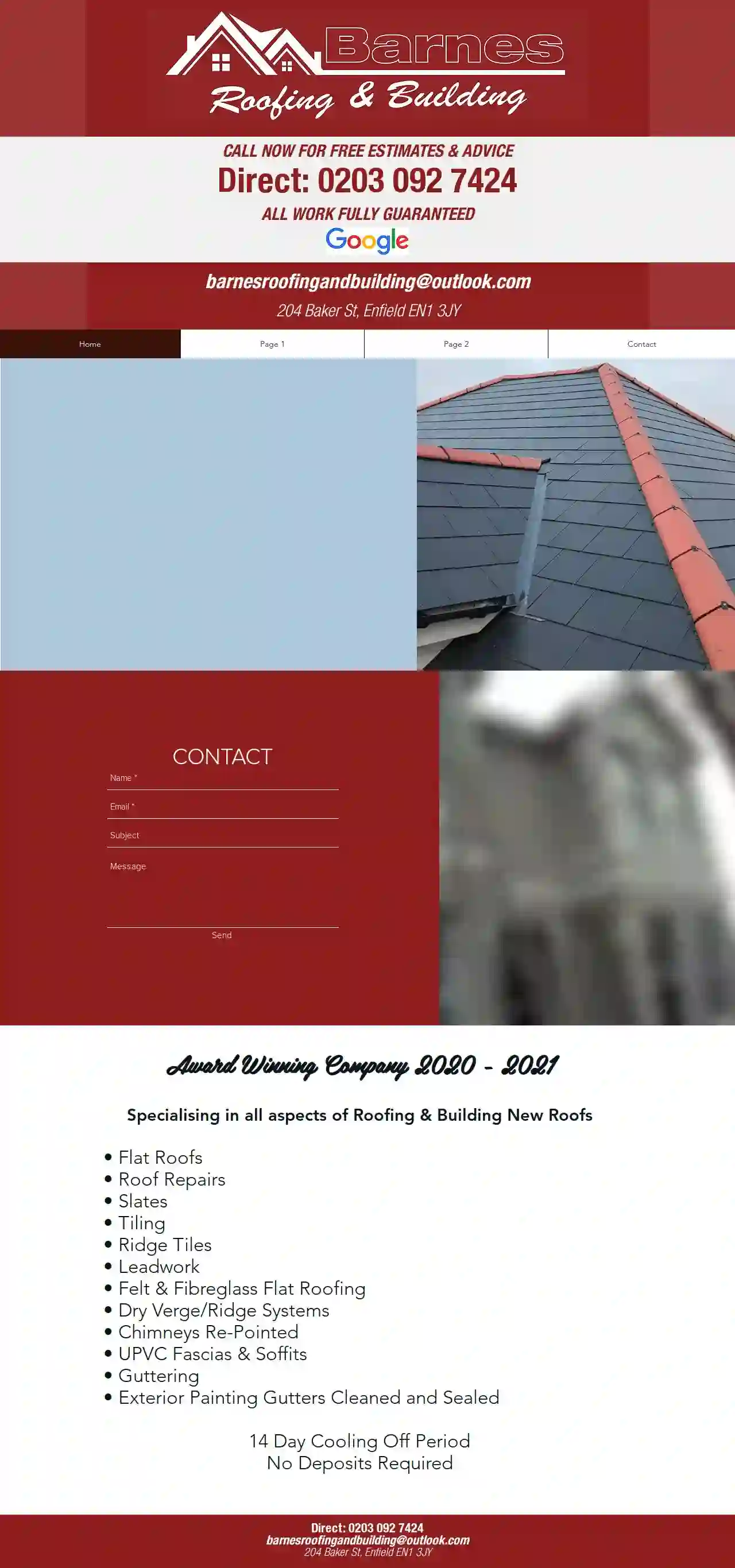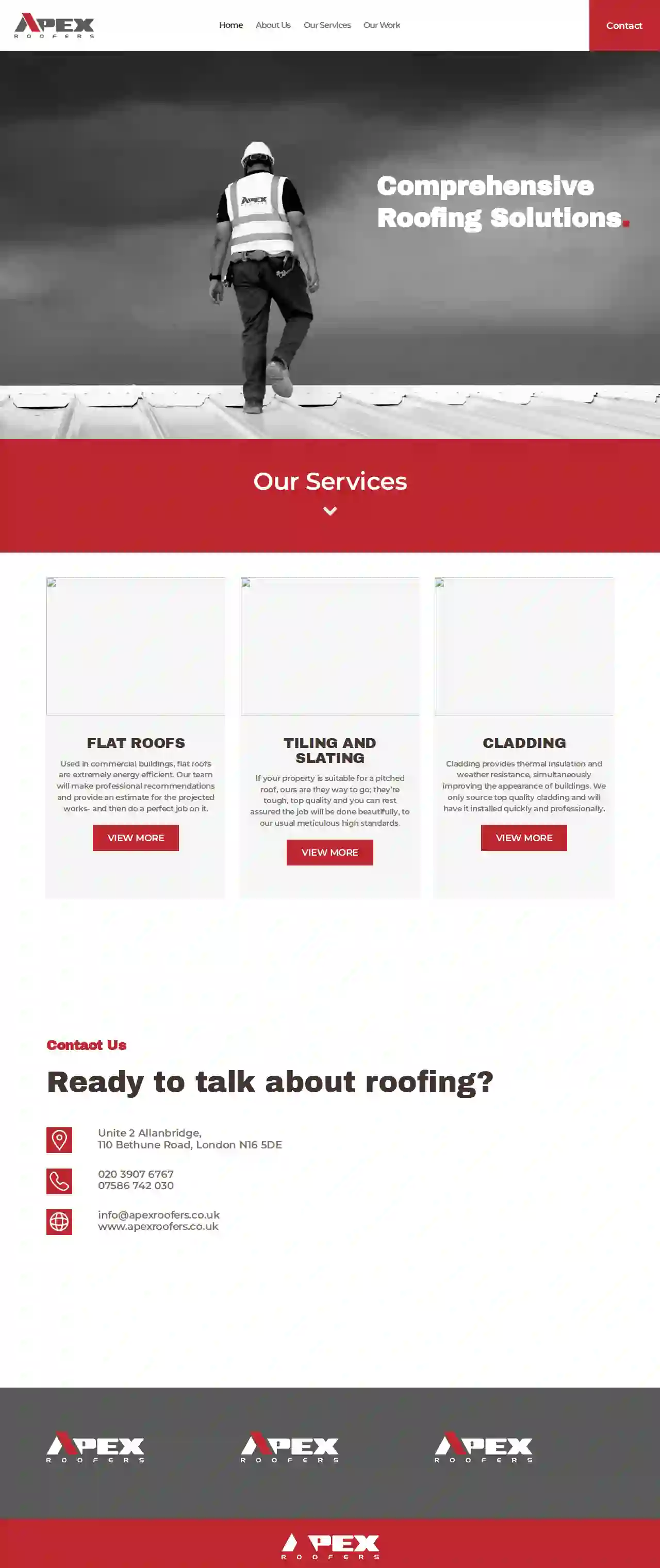Rubber Roof Installers Westminster
Top EPDM Roof Installer in Westminster
Receive 3 FREE Rubber Roofing Contractor quotes for your project today! Compare profiles, reviews, accreditations, portfolio, etc... and choose the best service.

Barnes Roofing & Building
4.39 reviews204 Baker St, Enfield, EN1 3JY, GBAward Winning Company 2020 - 2021. Specialising in all aspects of Roofing & Building New Roofs. We offer a wide range of services including Flat Roofs, Roof Repairs, Slates, Tiling, Ridge Tiles, Leadwork, Felt & Fibreglass Flat Roofing, Dry Verge/Ridge Systems, Chimneys Re-Pointed, UPVC Fascias & Soffits, Guttering, and Exterior Painting. Gutters Cleaned and Sealed. 14 Day Cooling Off Period. No Deposits Required.
- Services
- Why Us?
- Gallery
Get Quote
Hammersmith Roofing & Building
513 reviewsGBAt Hammersmith Roofing & Building, we are dedicated to providing our customers with exceptional service and top-quality workmanship. We understand that your home and roof are significant investments, and we take that responsibility seriously. Our goal is to surpass your expectations and ensure your complete satisfaction with our work. We offer a comprehensive range of building and roofing services, including roof repairs, installations, and replacements. Our services also encompass gutter and siding work to ensure your entire exterior is protected. No matter your roofing or building needs, our team is here to help. Our team comprises highly skilled and experienced builders and roofing professionals committed to delivering the best possible service to our customers. We prioritize ongoing training and development to stay abreast of the latest industry trends and techniques.
- Services
- Why Us?
- Gallery
Get Quote
A.C.E. Roofing Co. Ltd
519 reviewsLondon, GBA.C.E Roofing is a fully verified member of the Federation of Master Builders, to ensure absolute confidence for our clients. We have specialised in roofing installations and repairs of every imaginable kind for over forty years in London, Essex & the South East. Providing quality roof installations and repairs since 1976. We're your local expert roofing firm, with a skilled team of honest & conscientious workers based in Upminster, Essex, our work locations are the London Boroughs of Havering, Barking & Dagenham & Redbridge, Leyton, Leytonstone, Walthamstow, Woodford & Chingford, Chigwell, Abridge, Stapleford and West Horndon.
- Services
- Why Us?
- Accreditations
- Testimonials
- Gallery
Get Quote
Apex Roofers Ltd
4.935 reviewsUnite 2 Allanbridge, 110 Bethune Road, London, N16 5DE, GBComprehensive Roofing Solutions. Our Services FLAT ROOFS Main ServicesUsed in commercial buildings, flat roofs are extremely energy efficient. Our team will make professional recommendations and provide an estimate for the projected works- and then do a perfect job on it. VIEW MORE TILING AND SLATING Main ServicesIf your property is suitable for a pitched roof, ours are they way to go; they’re tough, top quality and you can rest assured the job will be done beautifully, to our usual meticulous high standards. VIEW MORE CLADDING Main ServicesCladding provides thermal insulation and weather resistance, simultaneously improving the appearance of buildings. We only source top quality cladding and will have it installed quickly and professionally. VIEW MOREContact UsReady to talk about roofing? Unite 2 Allanbridge,110 Bethune Road, London N16 5DE 020 3907 676707586 742 030 [email protected]
- Services
- Why Us?
- Gallery
Get Quote- As
Asgard Roofing - london roof specialist
533 reviewsLondon, GB- Services
- Why Us?
Get Quote - To
Topside Roofing Ltd
58 reviewsLondon, GB- Services
- Why Us?
Get Quote - Na
Nayburs roofing ltd
544 reviewsLondon, GB- Services
- Why Us?
Get Quote - X
X L Roofing
56 reviewsLondon, GB- Services
- Why Us?
Get Quote - FD
FD Roofing and Building
4.69 reviewsLondon, GB- Services
- Why Us?
Get Quote - To
Top Check Roofing Ltd
4.36 reviewsLondon, GB- Services
- Why Us?
Get Quote
Over 12,314+ Roofers registered
Our roofing experts operate in Westminster & surrounding areas!
Roofyng.co.uk has curated and vetted Top Roofing Businesses in and around Westminster. Find the most trustworthy contractor today.
Rubber Roof Installation FAQs
- Heat Absorption: EPDM's dark color absorbs heat, increasing cooling costs.
- Reflective Coatings: To combat heat absorption, consider a white or light-colored reflective coating over the EPDM membrane.
- Proper Ventilation: Adequate attic ventilation is essential to prevent excessive heat buildup under the roof.
- Clean the Area: Clean the area around the tear with a mild detergent and water, ensuring it's completely dry before proceeding.
- Cut a Patch: Cut a patch of EPDM membrane material that is slightly larger than the tear, ensuring it overlaps the damaged area by at least 2 inches on all sides.
- Apply Adhesive: Apply a specialized EPDM adhesive to the underside of the patch and the roof surface around the tear, following the manufacturer's instructions.
- Position the Patch: Carefully position the patch over the tear, pressing it firmly into place to ensure good adhesion.
- Roll the Patch: Use a roller to press out any air bubbles and ensure a smooth, even bond between the patch and the roof surface.
- Apply Sealant: Apply a bead of sealant around the patch's edges to provide additional protection against leaks.
- Inspect and Test: Once the adhesive and sealant have cured, inspect the repaired area and perform a water test to ensure it's watertight.
- Aesthetics: The black color of EPDM might not be visually appealing for all buildings or homeowners.
- Puncture Resistance: While durable, EPDM can be punctured by sharp objects.
- Seams: While fewer seams compared to shingles, seams are still potential leak points that need proper sealing.
- Fully Adhered: The EPDM membrane is fully glued to the roof deck using a specialized adhesive. This method provides excellent wind resistance and a smooth, aesthetically pleasing finish.
- Mechanically Attached: The EPDM membrane is fastened to the roof deck using screws and plates. This method is suitable for windy areas and allows for some movement of the membrane.
- Ballasted: The EPDM membrane is laid loose on the roof deck and held down with ballast, typically smooth river rock or pavers. This method is suitable for flat roofs and provides extra weight to resist wind uplift.
Are rubber roofs good in hot climates?
How do I repair a tear in my rubber roof?
Here's a general overview of the process:
What are the disadvantages of a rubber roof?
What are the different installation methods for rubber roofs?
Are rubber roofs good in hot climates?
- Heat Absorption: EPDM's dark color absorbs heat, increasing cooling costs.
- Reflective Coatings: To combat heat absorption, consider a white or light-colored reflective coating over the EPDM membrane.
- Proper Ventilation: Adequate attic ventilation is essential to prevent excessive heat buildup under the roof.
How do I repair a tear in my rubber roof?
Here's a general overview of the process:
- Clean the Area: Clean the area around the tear with a mild detergent and water, ensuring it's completely dry before proceeding.
- Cut a Patch: Cut a patch of EPDM membrane material that is slightly larger than the tear, ensuring it overlaps the damaged area by at least 2 inches on all sides.
- Apply Adhesive: Apply a specialized EPDM adhesive to the underside of the patch and the roof surface around the tear, following the manufacturer's instructions.
- Position the Patch: Carefully position the patch over the tear, pressing it firmly into place to ensure good adhesion.
- Roll the Patch: Use a roller to press out any air bubbles and ensure a smooth, even bond between the patch and the roof surface.
- Apply Sealant: Apply a bead of sealant around the patch's edges to provide additional protection against leaks.
- Inspect and Test: Once the adhesive and sealant have cured, inspect the repaired area and perform a water test to ensure it's watertight.
What are the disadvantages of a rubber roof?
- Aesthetics: The black color of EPDM might not be visually appealing for all buildings or homeowners.
- Puncture Resistance: While durable, EPDM can be punctured by sharp objects.
- Seams: While fewer seams compared to shingles, seams are still potential leak points that need proper sealing.
What are the different installation methods for rubber roofs?
- Fully Adhered: The EPDM membrane is fully glued to the roof deck using a specialized adhesive. This method provides excellent wind resistance and a smooth, aesthetically pleasing finish.
- Mechanically Attached: The EPDM membrane is fastened to the roof deck using screws and plates. This method is suitable for windy areas and allows for some movement of the membrane.
- Ballasted: The EPDM membrane is laid loose on the roof deck and held down with ballast, typically smooth river rock or pavers. This method is suitable for flat roofs and provides extra weight to resist wind uplift.